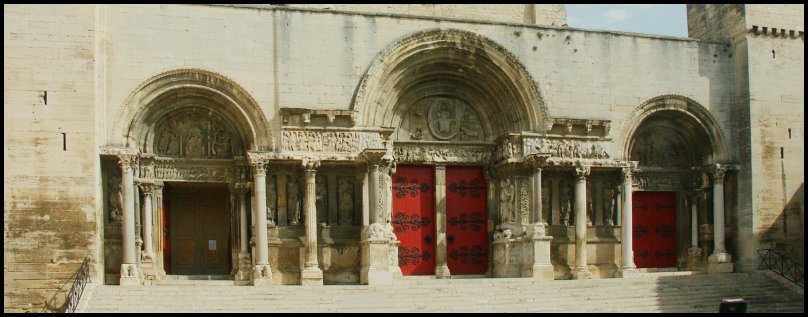
Introduction to Saint-Gilles-du-Gard
A major building campaign began in 1116 to build the crypt in the "lower" church. This area with the shrine to Saint Gilles was the important site for pilgrims, although the facade, begun later, is notable for the most spectacular ensemble of sculpture. Carra Ferguson O'Meara claims that the "richness and complexity of its architectural and sculptural composition rivals that of the west portals of the cathedral of Chartres and of the abbey church of Saint-Denis. . ." (2).
Unfortunately, much of this decoration was mutilated during the religious wars of the sixteenth century. A number of sculptors (6-8 and their assistants?) no doubt carved the ensemble on the facade, evident in part because their styles vary widely. (See Stoddard for details.) Stoddard dates this project as early as the late 1120s although other scholars have posited dates in the late 12th and early 13th centuries.
This church, influenced by the Roman architecture and sculpture in the area as well as early Christian sculpture (some now in the Arles museum), was also influential on other buildings, most notably St. Trophime, the stop before Saint-Gilles on the Via Tolosa.
Index to Images of Saint-Gilles-du-Gard
(145 images; all of the images of the front facade and interior were photographed in 2007)
Works Consulted or Quoted:
Alan Borg. Architectural Sculpture in Romanesque Provence. Oxford: Clarendon Press, 1972.
Kenneth John Conant. Carolingian and Romanesque Architecture: 800-1200. New York: Penguin, 1959; 1978.
Carra Ferguson O'Meara. The Iconography of the Facade of Saint-Gilles-du-Gard. New York: Garland, 1977.
Julie Roux [in collaboration with others]. The Roads to Santiago de Compostela. Vic-en-Bigorre Cedex, France: MSM, 1999-2004.
Whitney S. Stoddard. The Facade of Saint-Gilles-du-Gard: Its Influence on French Sculpture. Middletown, Conn: Wesleyan UP, 1973.
 Click here to return to index of art historical sites.
Click here to return to index of art historical sites.
 Click here to return to index of artists and architects.
Click here to return to index of artists and architects.
 Click here to return to chronological index.
Click here to return to chronological index.
 Click here to see the home page of Bluffton College.
Click here to see the home page of Bluffton College.
© 2007 Mary Ann Sullivan.
I have photographed (on site), scanned, and manipulated all the images on these pages. Please feel free to use them for personal or educational purposes. They are not available for commercial purposes.


 Click here to return to index of art historical sites.
Click here to return to index of art historical sites.
 Click here to return to index of artists and architects.
Click here to return to index of artists and architects.
 Click here to return to chronological index.
Click here to return to chronological index.
 Click here to see the home page of Bluffton College.
Click here to see the home page of Bluffton College.

